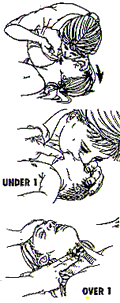CPR
In the past, we used the "ABC's of CPR " because it reminded us that there was a very specific order in which a person should be resuscitated. However, the American Heart Association updated its recommendations for CPR in October, 2010 and now recommends that an untrained rescuer begin chest compressions immediately. The ABC acronym has been changed to CAB.
Compressions
Airway
Breathing
Untrained rescuers should focus on continuous compressions and not perform mouth-to-mouth resuscitation if they are not familiar with it.
CPR FOR INFANTS (under 1 year)
EVALUATE your child's condition. Shout or gently shake your child to see if he will awaken. Put your ear next to his nose and listen for breathing. Look at the chest to see if it rises with each breath.
CALL FOR HELP. Have someone dial 911. If no one is available, do CPR for 2 minutes before calling 911.
IF YOUR CHILD IS NOT BREATHING OR WILL NOT AWAKEN:
POSITION your child. Put him on his back on a firm surface. If you think he could have injured his neck, support his head in order to keep the neck from twisting as you roll him over.
TILT THE HEAD BACK so that his nose is "in the air". Check the mouth to make sure your child has not choked on anything.

BEGIN CHEST COMPRESSIONS. With an infant, place two fingers on the breastbone, with your index finger at the height of the nipples. Compress at a depth of 1 1/2 inches (about 1/3 of the chest height) at a rate of two compressions per second. Do 30 compressions.
GIVE 2 RESCUE BREATHS. For an infant, place your mouth over his mouth and nose and breathe GENTLY, watching to see if the chest rises and falls. If not, readjust the head (see POSITION above), then give 2 breaths and return to chest compressions. NOTE: If the chest will not rise (or you do not know how to do rescue breaths), skip that step and just do chest compressions. You can try it again after 30 more compressions*.
*Continue chest compressions and breathing until paramedics arrive.
CPR FOR CHILDREN (1 to 8 years)
EVALUATE your child's condition. Shout or gently shake your child's shoulders to see if he will awaken. Put your ear next to his nose and listen for breathing. Look at the chest to see if it rises with each breath.
CALL FOR HELP. Have someone dial 911. If no one is available, do CPR for 2 minutes before calling 911.
IF YOUR CHILD IS NOT BREATHING OR WILL NOT AWAKEN:
POSITION your child. Put him on his back on a firm surface. If you think he could have injured his neck, support his head in order to keep the neck from twisting as you roll him over.
TILT THE HEAD BACK so that his nose is "in the air". Check the mouth to make sure your child has not choked on anything.

BEGIN CHEST COMPRESSIONS. For a child, put one hand on the chest between his nipples. Lock your elbows and press straight down about 2 inches. Continue for 30 compressions at a rate of two compressions per second.
GIVE 2 RESCUE BREATHS. For a child, place your mouth over his mouth and press his nose shut with your fingers. Breathe GENTLY, watching to see if the chest rises and falls. If not, readjust the head (see POSITION above), then give 2 breaths and return to chest compressions. NOTE: If the chest will not rise (or you do not know how to do rescue breaths), skip that step and just do chest compressions. You can try it again after 30 more compressions*.
*Continue chest compressions and breathing until paramedics arrive.
CPR FOR OLDER CHILDREN & ADULTS
EVALUATE THE VICTIM Shout or gently shake her shoulders to see if she will awaken. Put your ear next to her nose and listen for breathing. Look at the chest to see if it rises with each breath.
CALL FOR HELP. Have someone dial 911. If no one is available, do CPR for 2 minutes before calling 911.
IF THE VICTIM IS NOT BREATHING OR WILL NOT AWAKEN:
POSITION the victim. Put her on her back on a firm surface. If you think she could have injured her neck, support her head in order to keep the neck from twisting as you roll her over.
TILT THE HEAD BACK so that her nose is "in the air". Use a "Chin Lift" by pulling up on the back of the jaw to open the airway. If you did not witness the event, check the mouth to see if there is any food/foreign body.
BEGIN CHEST COMPRESSIONS. Put the heel of your hand in the middle of her chest, placing the other hand over the first hand. Lock your elbows and press straight down about 2 inches. Allow the chest to return to its normal position. Continue for 30 compressions at a rate of 100 times a minute. (Some people recommend that you press to the beat of "Stayin' Alive").
If you have NOT been trained in CPR, you may continue to just give chest compressions until help arrives or the victim wakes up. Otherwise, proceed to give rescue breaths.
If you are in a public building that has an automated external defibrillator (AED), turn it on. If you saw the victim collapse, attach the AED immediately and follow the instructions. Otherwise, perfom CPR for 1 minute before using the AED.
GIVE 2 RESCUE BREATHS. Place your mouth over her mouth (or use a CPR mask if available) and press her nose shut with your fingers. Breathe GENTLY, watching to see if the chest rises and falls. If not, readjust the head (see POSITION above), then give 2 breaths and return to chest compressions. NOTE: If the chest will not rise (or you do not know how to do rescue breaths), skip that step and just do chest compressions. You can try it again after 30 more compressions*.
*Continue chest compressions and breathing until paramedics arrive.
